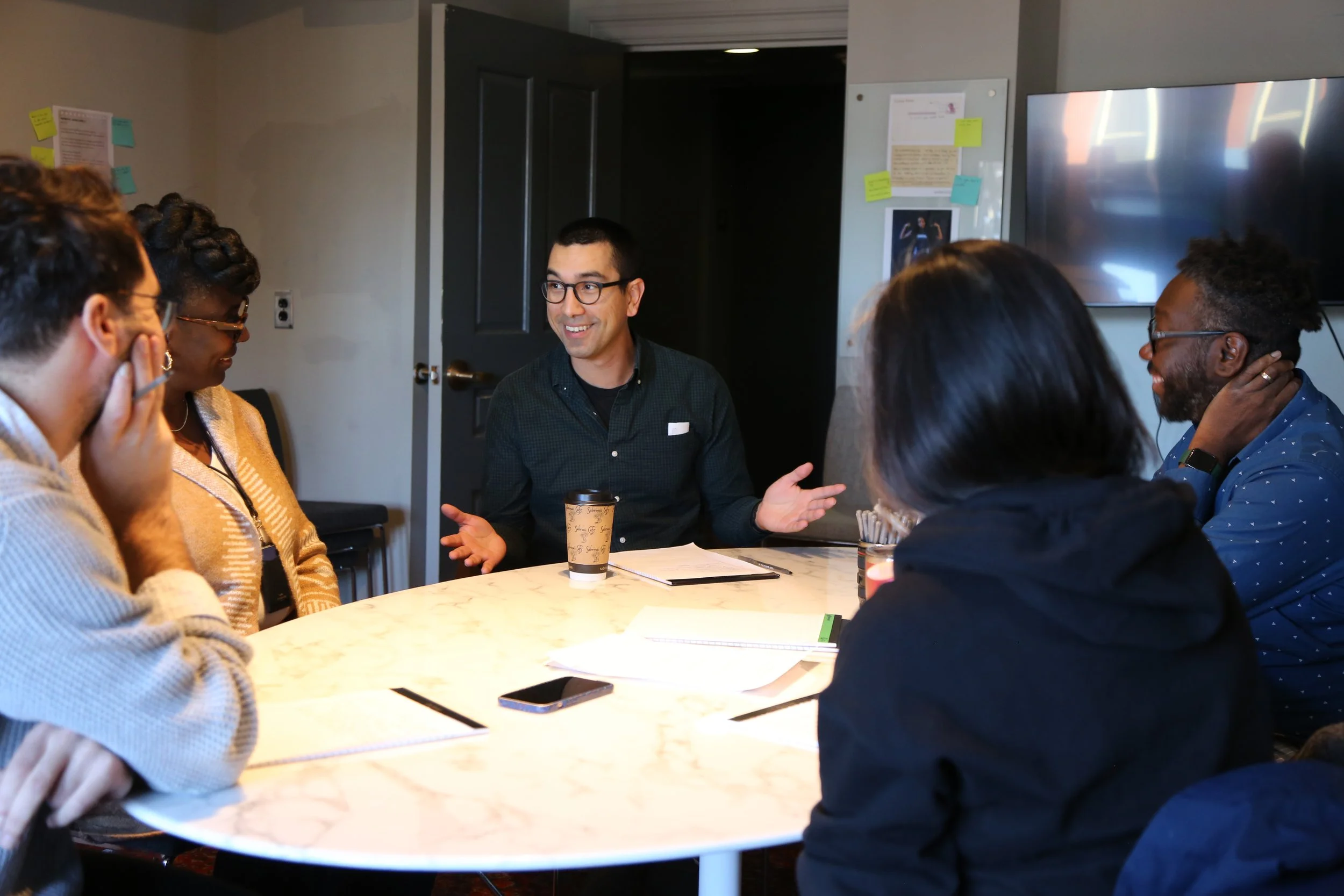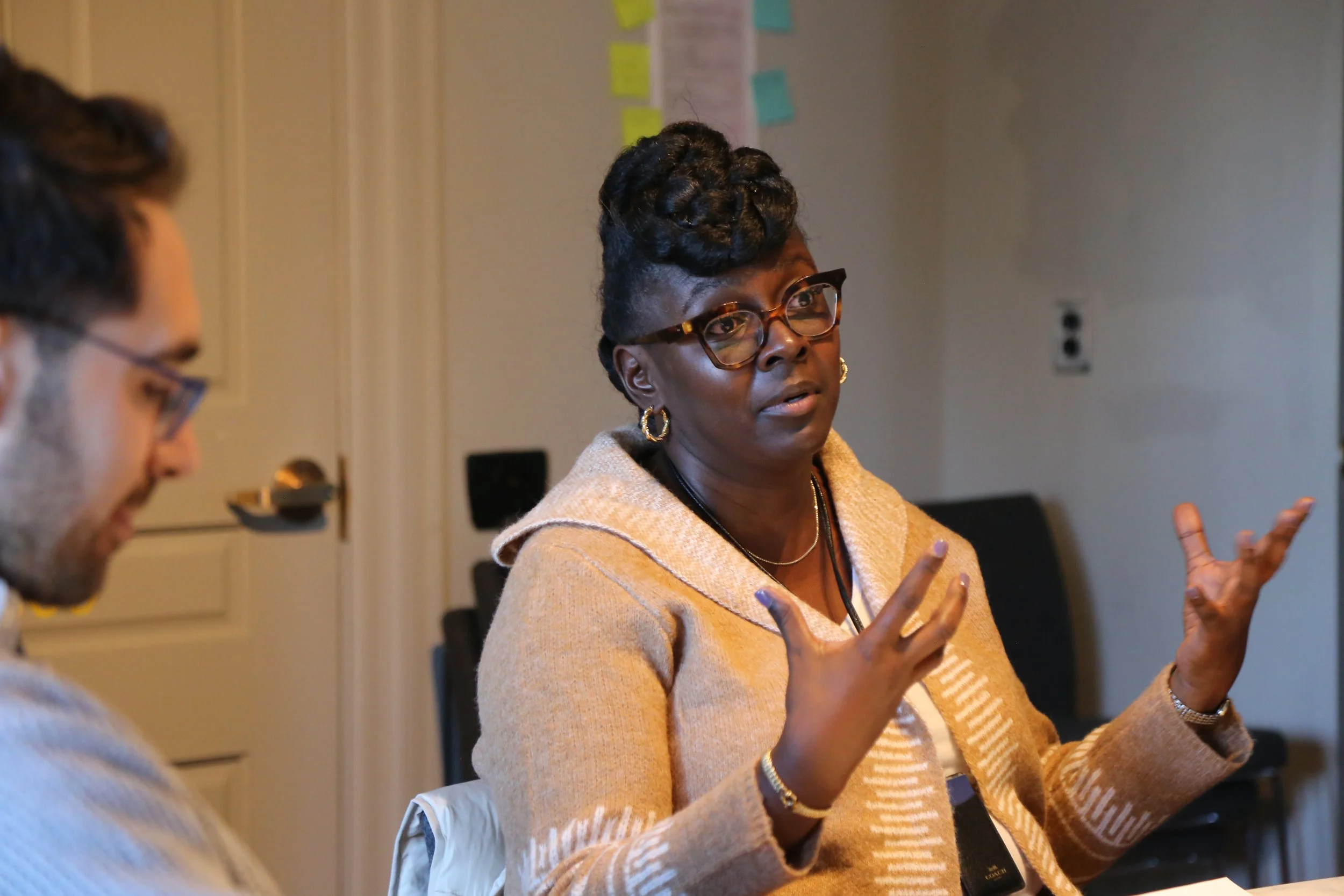
UNMAPPING
PUBLIC HEALTH
Project lead Steve Vásquez Dolph met with 2023-24 UnMapping Instructors, Helen Teng, Monica Harmon, and 2024-25 UnMapping Instructor Tariem Burroughs to discuss public health and its role in the community and classroom particularly in the wake of the election.
Edited for length and clarity
Steve: our conversation will be about the stories we tell about our work - The stories that connect lots of different kinds of educational projects across disciplines. Everyone at the table is doing some kind of community health work in very different spaces. A whole imaginary around health that isn't just this injury or this trauma. It is all this big story around their lives. I'm hoping you talk about the way in which storytelling practices inform your health care work as mentors, as community liaisons, as leaders.
Tariem: I'm going to say it's hard because a lot of people don't know how to tell a story or even tell their own story. A place to start from is just having a simple conversation. We've all worked with students and it's like, “Come on, man, just come on, give me a full sense of what you want.” It's just constant working and mirroring how to tell a story. Once they figure out how to tell their own story, they can really understand other people's stories and how those stories are important, but it's really hard to understand or ask for someone else's story if you don't know how to tell or look at a story.
Helen: It's also important to create a safe space. They have to trust us to be able to tell us our stories. I feel like sometimes our students may be too shy to ask the community members questions because they don't want to be too “nosy” or “inappropriate.” But I think there's a balance with healthy curiosity that will help us inform how we may better care for them.
Monica: Yeah, I think I agree with both of you. I think there is a vulnerability in storytelling. The people we work with, telling their story can make them more vulnerable, can get them injured, get them robbed. When telling your story, people may not understand you fully and that's hard for people. The other thing is recognizing when someone is telling you a story. Sometimes we get so busy in our work that we forget there's some pieces or clues that we're given showing something being said matters, or do we need to do something else to dig a bit more?
Tariem: I will also add to these ideas of safe spaces, and particularly in regard to the many focus groups and community meetings. Sometimes they can get out of pocket.
*Laughs*
Helen: Tell me more.
Monica: How so?
Tariem: You know, you always deal with groupthink. People just chime in, but there's always one person breaking the groupthink, and throws that little bomb out. How do we deal with it? I’m saying no space is ever 100% safe, but that's also where resiliency comes in. You have to be OK with being challenged, especially when you're doing community work. [That one person] tends to be like, “No, it's actually this.” But if you're not ready to listen or have an actual conversation to learn more, then you're going to miss out on a huge thing. Whatever intervention or whatever you're trying to do with these people will either A.) not work or B.) not be sustainable or C.) you're just going to miss out on people.
Helen: I think that's such a great point. I didn't start to appreciate that until I joined the Sim Center, where I really understood what psychological safety means. It means we are in a space where we feel safe enough to take a risk with each other. And that's what we create in community health, right? A lot of people think safe space is like a warm fuzzy bunny. No, that is not it, it's a misnomer. It is actually creating a space where people feel like they can take risks. Let people know it's OK and that there are no negative ramifications on them. It won't reflect poorly on them.
Left to right: Monica Harmon, Tarriem Burroughs, Helen Teng
Monica: Yeah, I agree, but also a lot of students I teach are not going to work in community health or public health. What I want them to start thinking about is what they're putting into the world and how it impacts everyone. In our class, we had professional students. We have chemists and biochemists, bioengineers. They don't want to talk to people. When they came out of that class, they said, "I'm really going to start thinking about the people who use the stuff I create.” And for me, that's the point.
I want [students] to understand that healthcare begins and ends in the community. Whatever we do as healthcare workers impacts those communities and we want to make sure that we have positive impacts. We also reflect on what you do, what was said to you, what did you feel, whether it was good or bad. All of that is building up professional muscles, so to speak. It'll help you to better meet the needs of those community members as well. I also challenge them not to take the bus to their job or drive their car and park. Instead, I encourage them to really take the time to walk in the shoes of those who come to you as well. I make myself walk the neighborhood as well because I want to feel what others are feeling. I want to walk those streets. I want to feel the concrete under my feet. I want to see that. That empathy, thinking about whatever you put out in the world and how it impacts other people. It's huge.
Helen: Yeah, kind of adding to what's already been said. Something I've learned in working with the community I'm in: it takes a village to take care of even one individual patient, sometimes based on their care needs. Even in our low resource environment, we were still able to get take care of someone who initially came to us with a controlled diabetes, who was legally blind, who has no status in this country, who has no insurance, no family, no money, and our other volunteers was the one paying his rent. They were living in spaces that were just individual rooms. Then, some of the medical students took this patient to their medical appointments and our volunteer social worker helped apply for emergency medical assistance. I was able to get him approved for a year, and now we're able to extend that, so that he can continually get his medications and get his conditions under control. I think that example really shows that it takes a village for us to practice community health...
To your point, Monica, thinking about our students, and how they don't think about going into the community... [but] health can take place anywhere in the community. We provided health in a library space for the longest time. Monica was the one that started that for Penn Nursing. I was able to be part of that after she had transitioned. Some of the patients that we have come in contact within the library space really value the conversations we're able to have around their health because they're not able to have those conversations with their providers due to the way our insurance systems work. I think part of the community is to supplement our current systems that are not working well for our individual patients and communities.
Monica: One thing we didn't talk about is that we all work for the university, and we all know the struggles we have here. The first thing when thinking about where to make cuts will be community. We have to be brave and really be steadfast when we're asked, “What can you cut?” or “What can we do differently?” Yesterday, I had to send an email to one of my up lines and I said, “Listen, what I do know about community and whatever plans you have for the future of Drexel, it’s always about presence and relationship. If you're asking me to cut back, you're asking me to jeopardize the relationships that I've created as well as the ones that are yet to come.”
...That is very challenging because you walk in between two worlds sometimes. The one with the community members, they don't need to know all the inner workings of the university, just like the university really doesn't [see] all the inner workings of the community. Those are challenges I face, but I'm also very honest with students in the classroom because I want them to know this is what they will face as well. These are the challenges that we see now, but they’re going to have to deal with the repercussions of those challenges too. So how will they be creative in their thinking?
Tariem: We're going to have to be very creative in everything we do. But also saying that the point of these relationships is “what is our mission here?” If you said our mission is X and you're realizing you're going to cut next, then are you really living up to your mission? If you're not, then you need some soul searching.




